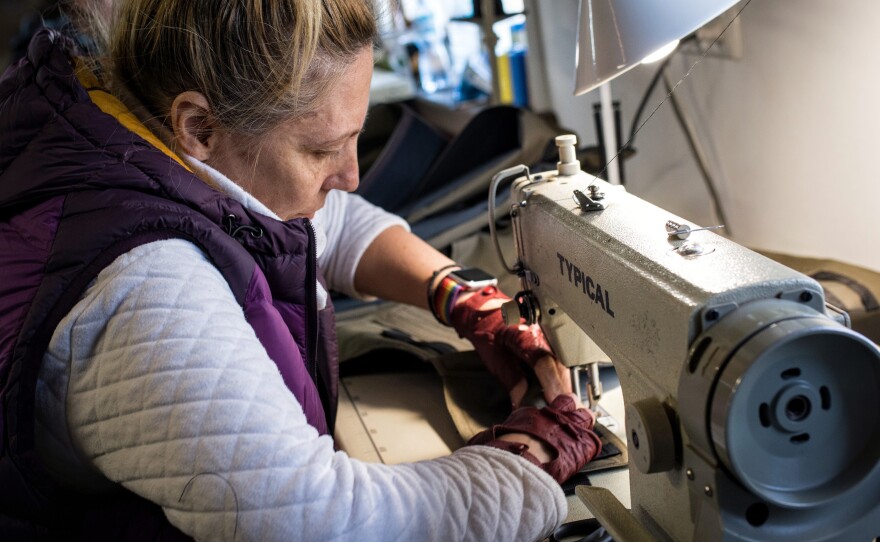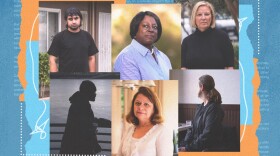Updated April 1, 2022 at 12:20 PM ET
ZAPORIZHZHIA, Ukraine — Before the war, Vasyl Busharov was an event planner. "I was a master of ceremonies!" he says with a dramatic wave of his hand. Now he's overseeing hundreds of wartime volunteers in a crumbling, Soviet-era industrial compound.
Among other things, the volunteers are making bulletproof vests out of scrap metal.
"Used cars, old cars, we use them to make [the vests] and it does work," he says. "I can assure you, we shot at the plates and had a good result." They even brought in some soldiers to help test their products out.
As the war has upended normal life, Ukrainians are volunteering in droves to help. Some are signing up to fight. Some are preparing meals. Others are helping those who've fled find transportation and places to sleep.
Switching between English, Ukrainian and Russian, Busharov rattles off everything volunteers have been doing around this compound in Zaporizhzhia, some 25 miles from the front lines. In addition to producing body armor and serving as a logistics hub to extract people from Russian-occupied areas, the compound is a distribution point for humanitarian supplies, its rooms filled with donated canned food, pasta, shampoo and diapers.
Mechanics work next to business consultants packing sandbags. Teachers coordinate delivery schedules.
"We were transporting sandbags from one place to another," Busharov says, to help barricade various branches of Ukraine's security forces. "Our team managed to transfer 2,000 tons of sand in 10 days."

Mechanics are fixing car windows and welders make homemade bulletproof vests
Most of those who've fled to Zaporizhzhia don't stay. Many want to get as far away from the front lines as possible, even all the way to Poland. The volunteer mechanics try to help them get there. They help patch up vehicles and replace windshields if they can.
"There is a special division here of guys who help to fix the car windows," Busharov says. "Because almost all the cars that get in here have broken windows."
Russian forces have been bombing areas heavily before moving in with ground troops, and the bombs blow out the windows of apartments and cars anywhere nearby.
Welders and seamstresses are busy putting together body armor. Aleksii Simchenko is using his welding skills to make breastplates for bulletproof vests.
"First, the root seam is welded," he explains as he lines up strips of steel on a workbench in front of him. The pieces of metal are cut out of springs from a truck's suspension. Simchenko welds them into a square plate. "Then the plate is sent for resurfacing to the metalwork workshop."
Men wearing goggles grind down the welds to make smooth plates about the size of a fashion magazine.
Up a steep set of stairs from the metal shop, a dozen sewing machines surround a large work table. Women are sewing the canvas vests that will hold the steel plates being made downstairs.
Elena Grekova runs the sewing end of the production. Prior to the Russian invasion, she was a fashion designer who sold her creations in boutiques in Kyiv.
A month ago, she'd never made a bulletproof vest. "Never!" she says with a laugh. "Only clothes and shoes." One of the seamstresses chimes in that Grekova does "high fashion."
Now she's making bulky green camouflage body armor — 30-lb. garments designed to deflect a round from an AK-47. "In a day, we can produce 20 to 25 bulletproof vests," Grekova says.

Some volunteers are risking their lives to help others escape Russian-controlled areas
The warehouse complex is also a staging ground for volunteers who drive into Russian-controlled areas each day to try to evacuate people from the conflict.
One of them, Algiz Yarmash, crosses the shifting front lines to try to extract those who have no other way to flee. In his prewar life, just a few weeks ago, he was a business coach for entrepreneurs.
"We started evacuating people from Mariupol and other occupied territories," Yarmash says. "Often we are stopped by Russian troops, they make us get off the road and they point guns at us."
Several of his cell phones have been seized. But he and his fellow volunteers insist that they're humanitarian workers, and so far they've been released.
"You can see the big difference between people who are afraid and people who are eager to help," Busharov, the volunteer coordinator, says.
Volunteers show up every morning. He says Ukrainians want to help their fellow citizens. The war has brought out the best in a lot of people, he says: They want to make sure the guys at the makeshift security barricades have bulletproof vests. They want to extract elderly couples out of Mariupol.
"And this time, I have seen so many people that will — they will probably be called my best friends in future," he says.
The war, he says, is making ordinary people do extraordinary things.
Hanna Palamarenko contributed to this story from Zaporizhzhia.
Copyright 2022 NPR. To see more, visit https://www.npr.org. 9(MDAzMjM2NDYzMDEyMzc1Njk5NjAxNzY3OQ001))







